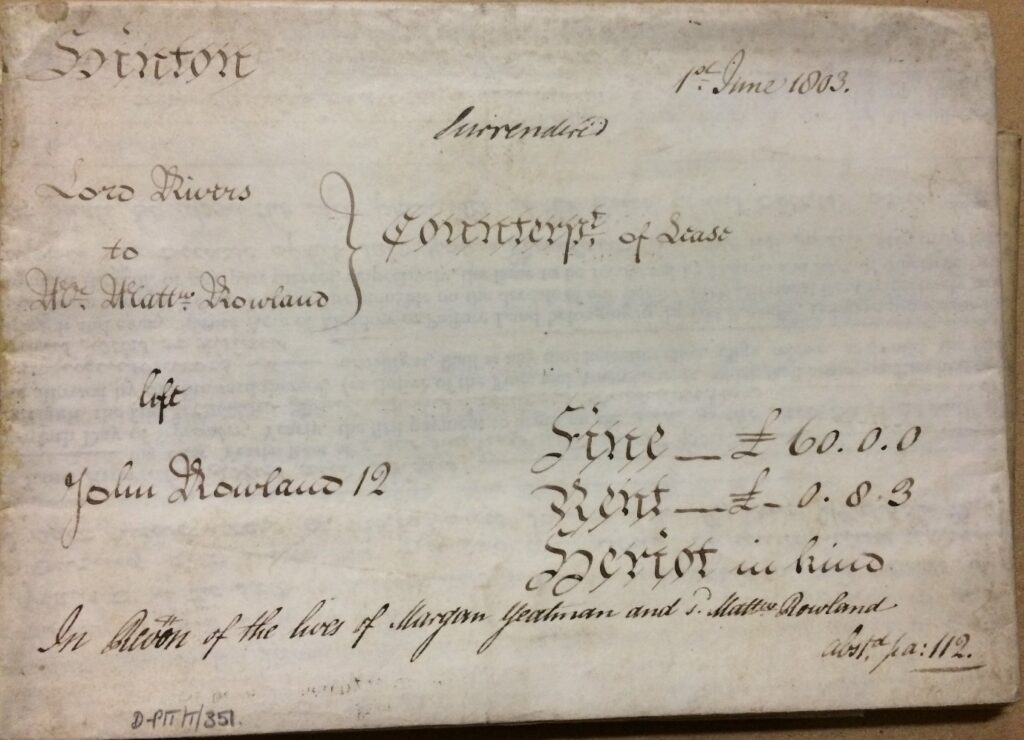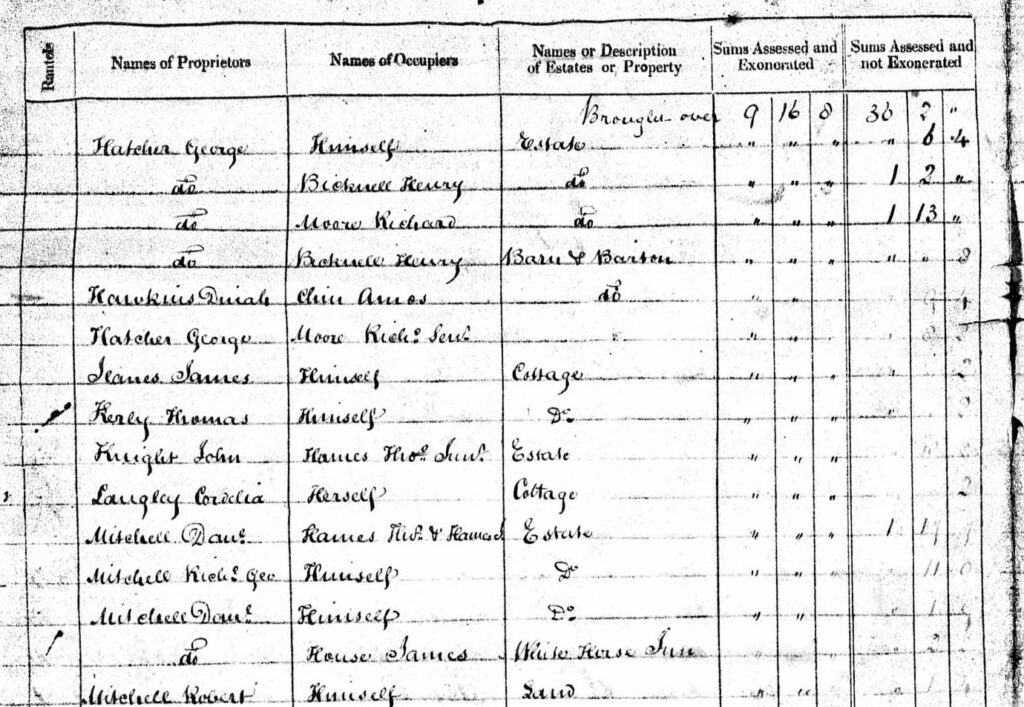Sometimes forums such as the Dorset History Centre blog can uncover further stories in your family history or information on a village or house history to add to your research.
The recent two part blog by Valerie Brenton (here and here) following a family in Sturminster Newton Workhouse, some of whom emigrated to Newfoundland, chimed with some research for a Building History workshop undertaken by our Principal Archivist Jacqui Halewood some years ago…
—
Valerie found that their mother Elizabeth Roberts had been buried at Hinton St Mary three days before their admission to the workhouse and noted that presumably their father and other family members were unable or unwilling to care for the six children. Valerie discovered that the father, John Roberts, had married Elizabeth Rowlands at Hinton St Mary in December 1808. It was the Rowlands connection that piqued my interest.
Using both records found on Ancestry.co.uk and other documents available only at the Dorset History Centre, this research centred around The White Horse pub in Hinton St Mary. This is a Grade II listed building and described as a late 18th, early 19th century building, although there was certainly a place, of that name, used as an Alehouse in Hinton St Mary from at least 1753.
Alehouse Recognisances are documents recording the early form of licencing of any place selling alcohol (for Dorset these are available on Ancestry.co.uk). The licensee paid a fee as a bond to pledge to keep an orderly house, abiding by the assize of ale, not allowing unlawful gaming or ‘tippling and drinking contrary to the law’ and not to shelter beggars and vagabonds. Alehouses ranged from coaching inns to something little more than the parlour or kitchen of a cottage used to serve beer from a tapped barrel. The Recognisance Registers list the licensee and two sureties. From around the 1750s they include the name of the alehouse so pub names can be identified for the first time. Usually the alehouse keepers stood surety for each other in the same area.
From 1753 Nathaniel Stacy is listed at The White Horse in Hinton St Mary but he had been a victualler in Hinton St Mary since at least 1727 and was latterly described as a clothier. Nathaniel was buried in Hinton St Mary in July 1759 and in September the licensee is listed as Sarah Belben who on 3 March 1760 married John Rowland. John Rowland and others of the Rowland family were victuallers mainly in Sturminster Newton, a family that included a Joseph, Robert and Susannah. John himself held a licence there in 1758 and 1759 as well as standing surety for Nathaniel Stacy at The White Horse in 1758.

A Sarah Rowland, wife of John Rowland is buried in April 1778 in Hinton St Mary, but no age is given. It has been difficult to identify Sarah Belben’s background, although a Robert Belben was the licensee at the White Bear in nearby Child Okeford. If we guess that one of the two Sarah Belben’s that were baptised in Dorset in 1744/5 is correct, this could make her 16 when taking on the licence of The White Horse. Perhaps she was baptised in childhood rather than as a baby, as many children were, including some of her descendants. Many women, especially widows were alehouse keepers but a girl of 16, is perhaps unusual, though she may have had support from other alehouse keepers in the family.
John and Sarah had at least four children before Sarah’s death in 1778 and John appears to have remained a widower until he died in 1802, aged 70. His will is amongst the records at DHC and also available on Ancestry.co.uk. He mentions only two children and appears to have been relatively comfortably off for the period with bequests of gold rings to his 6 granddaughters and to his daughter Susannah Hames.

The will also lists his brewing equipment which he leaves to his son Matthew Rowland, who was the licensee by September 1803.
The will also reflects different types of land holding at this time. By his will John was able to devise his property in Sturminster Newton to his daughter Susannah and son in law Thomas Hames and their son forever whilst leaving only the estate term and interest in his lands in Hinton St Mary, probably including The White Horse to his son Matthew.
The White Horse is on the Pitt Rivers estate, near to the manor house and opposite the church in Hinton St Mary and was a copyhold tenancy of the manor. Copyhold was where the land remained in the ownership of the lord of the manor and originally was subject to specific duties due to the manor by the tenant. The rights and duties of each manor often differed according to custom. The origin of the term copyhold was that the tenant received a copy of the entry in the manor court roll relating to his tenancy.
The White Horse on the Pitt Rivers manor in the 18th century was held as copyhold for lives. A copyhold for lives named, usually three people, who were expected to succeed each other as the tenant of the holding. The first paid rent and the heriot [entry fine] whilst the other two were “in reversion and remainder” so would be the next tenants in succession after the death of the first named person. A new third named life could then be nominated to follow on. The succeeding ‘lives’ in reversion and remainder could be changed during the lifetime of any one of the tenants upon payment of a fine to the lord. Often sons and grandsons were named as the succeeding lives but sometimes, as in this case, children predeceased their fathers, which led to tenancies being inherited outside the family. It was not usually possible for these holdings to be sold, but by the 18th century on many manors this type of tenancy was being changed by the landowners to leasehold for a period of years and by the early 19th century many were being converted to freehold land which could be bought and sold. It is likely that by the 1830s The White Horse was a freehold property.
There are documents relating to The White Horse in the Pitt Rivers collection at DHC which show this copyhold for lives in operation. The deeds for the property tell us who held this copyhold for lives tenancy and who were in reversion and remainder. Three named people or lives were listed on the deed each time a tenant died. This deed is the admittance to the tenancy of Matthew Rowland in 1803 after his father’s death. It names Matthew’s son John aged 12 as the next life. Unfortunately, this John Rowland died in 1822 at the age of 32 and so predeceased his father who died in 1835, demonstrating the insecurity of the copyhold for lives system for the family.

—
So, what of the link to the Roberts children who were admitted to the Sturminster Newton Workhouse in 1824?
Matthew Rowland married Betty (Elizabeth) Mullens in Hinton St Mary in 1786 and they appear to have at least nine children, four boys and five girls. Elizabeth, who later marries John Roberts, is the eldest child. Matthew Rowland, then, is the grandfather of the Roberts children. When his daughter Elizabeth dies at the age of 38 in May 1824, he was a widower of around 63 years old, probably still licensee of The White Horse. Matthew’s wife, the children’s grandmother had died in November 1821 and son John Rowland in June 1822, aged 32. He still had four unmarried adult children aged between 18 and 26. So taking in 6 young grandchildren was not likely to be an easy option.
There does appear to have been a problem with early morbidity in this family. Elizabeth had died at 38 in 1824 and her four brothers all died in their thirties between 1822 and 1841. Though the 1830s were a time of agricultural depression in Dorset this seems a high rate for a family that a generation earlier appeared to be prospering.
Matthew died in 1835 aged 73 but according to the Land Tax return by 1832 Daniel Mitchell was the proprietor of The White Horse with a James House as occupier, and by the 1841 census Daniel Mitchell is described as the innkeeper at The White Horse. There are no Alehouse Registers by this date to confirm the change in licensee and no other documents have been found to show exactly when this change of proprietor of The White Horse happened.

The Rowlands appear to have had a link with the Mitchells in Hinton St Mary as an Elizabeth Mitchell was a witness at the marriage of Elizabeth Rowland and John Roberts in 1808 and an Elizabeth Mitchell married John Rowland, Elizabeth Robert’s brother, in 1814. This link could explain the youngest of the Roberts children, Hester, being sent to a Mrs Mitchell in Hinton St Mary in 1828.
Whatever the story behind the Roberts children entering the workhouse in 1824, the most successful of the Roberts brothers to go to Newfoundland continued to preserve the link with Dorset and his Rowland ancestors as he gave the Rowland name as a middle name for his children.


Fascinating story. John Rowland Roberts is my ancestor and was one of the earliest settlers in Bonne Bay Newfoundland. My grandmother was a Roberts from that community and we have traced her to John, (assuming my info is correct) but I knew very little about John or Elizabeth prior to reading your research. I am half inclined to visit Hinton St. Mary, in particular, The White Horse.
The fact That John survived his early life, the trip to Newfoundland and actually prospered, is amazing. I understand one of his other brothers later joined him in Bonne Bay but I’ve often wondered what became of the other children. Quite a story.
Thank You.
Greg Watton
Hi Greg, thank-you for your reply and we are glad that you’ve discovered this blog and its proven interesting and useful to you!
Is the White Horse still there?
As far as we know the pub is still there: https://www.thewhitehorsehinton.co.uk/
Thanks. i think i will have to pay a visit one day. if i flew into London, how would i get to this area? train?